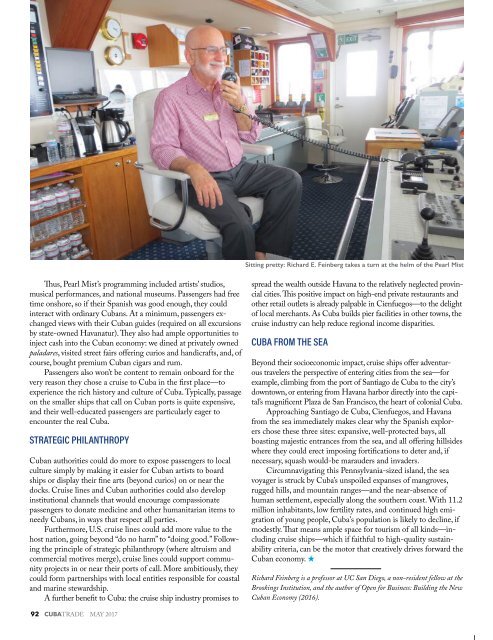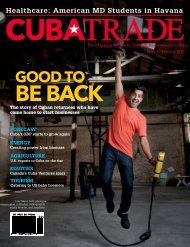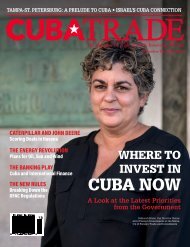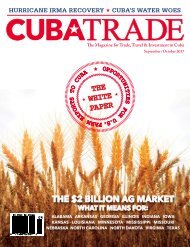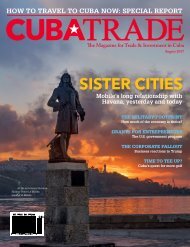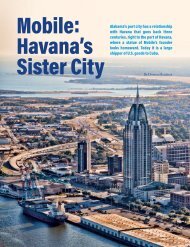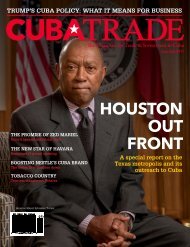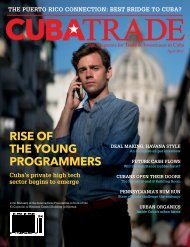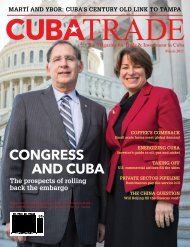CubaTrade-May2017-Flipbook
You also want an ePaper? Increase the reach of your titles
YUMPU automatically turns print PDFs into web optimized ePapers that Google loves.
Don’t miss any issues...<br />
SUBSCRIBE NOW!<br />
TIMELY<br />
Thus, Pearl Mist’s programming included artists’ studios,<br />
musical performances, and national museums. Passengers had free<br />
time onshore, so if their Spanish was good enough, they could<br />
interact with ordinary Cubans. At a minimum, passengers exchanged<br />
views with their Cuban guides (required on all excursions<br />
by state-owned Havanatur). They also had ample opportunities to<br />
inject cash into the Cuban economy: we dined at privately owned<br />
paladares, visited street fairs offering curios and handicrafts, and, of<br />
course, bought premium Cuban cigars and rum.<br />
Passengers also won’t be content to remain onboard for the<br />
very reason they chose a cruise to Cuba in the first place––to<br />
experience the rich history and culture of Cuba. Typically, passage<br />
on the smaller ships that call on Cuban ports is quite expensive,<br />
and their well-educated passengers are particularly eager to<br />
encounter the real Cuba.<br />
STRATEGIC PHILANTHROPY<br />
Cuban authorities could do more to expose passengers to local<br />
culture simply by making it easier for Cuban artists to board<br />
ships or display their fine arts (beyond curios) on or near the<br />
docks. Cruise lines and Cuban authorities could also develop<br />
institutional channels that would encourage compassionate<br />
passengers to donate medicine and other humanitarian items to<br />
needy Cubans, in ways that respect all parties.<br />
Furthermore, U.S. cruise lines could add more value to the<br />
host nation, going beyond “do no harm” to “doing good.” Following<br />
the principle of strategic philanthropy (where altruism and<br />
commercial motives merge), cruise lines could support community<br />
projects in or near their ports of call. More ambitiously, they<br />
could form partnerships with local entities responsible for coastal<br />
and marine stewardship.<br />
A further benefit to Cuba: the cruise ship industry promises to<br />
Sitting pretty: Richard E. Feinberg takes a turn at the helm of the Pearl Mist<br />
spread the wealth outside Havana to the relatively neglected provincial<br />
cities. This positive impact on high-end private restaurants and<br />
other retail outlets is already palpable in Cienfuegos—to the delight<br />
of local merchants. As Cuba builds pier facilities in other towns, the<br />
cruise industry can help reduce regional income disparities.<br />
CUBA FROM THE SEA<br />
Beyond their socioeconomic impact, cruise ships offer adventurous<br />
travelers the perspective of entering cities from the sea—for<br />
example, climbing from the port of Santiago de Cuba to the city’s<br />
downtown, or entering from Havana harbor directly into the capital’s<br />
magnificent Plaza de San Francisco, the heart of colonial Cuba.<br />
Approaching Santiago de Cuba, Cienfuegos, and Havana<br />
from the sea immediately makes clear why the Spanish explorers<br />
chose these three sites: expansive, well-protected bays, all<br />
boasting majestic entrances from the sea, and all offering hillsides<br />
where they could erect imposing fortifications to deter and, if<br />
necessary, squash would-be marauders and invaders.<br />
Circumnavigating this Pennsylvania-sized island, the sea<br />
voyager is struck by Cuba’s unspoiled expanses of mangroves,<br />
rugged hills, and mountain ranges—and the near-absence of<br />
human settlement, especially along the southern coast. With 11.2<br />
million inhabitants, low fertility rates, and continued high emigration<br />
of young people, Cuba's population is likely to decline, if<br />
modestly. That means ample space for tourism of all kinds—including<br />
cruise ships—which if faithful to high-quality sustainability<br />
criteria, can be the motor that creatively drives forward the<br />
Cuban economy. H<br />
Richard Feinberg is a professor at UC San Diego, a non-resident fellow at the<br />
Brookings Institution, and the author of Open for Business: Building the New<br />
Cuban Economy (2016).<br />
TARGETED<br />
EFFECTIVE<br />
Everything you need to know on:<br />
Tourism Transportation Agriculture Investments<br />
Energy Manufacturing And much more …..<br />
RECEIVE 11 ISSUES DELIVERED DIRECTLY TO YOU FOR ONLY<br />
$29.99<br />
That’s like getting 6 issues FREE! *<br />
Subscribe online at cubatrademagazine.com<br />
* Newsstands price $5.99 per issue<br />
92 CUBATRADE MAY 2017


